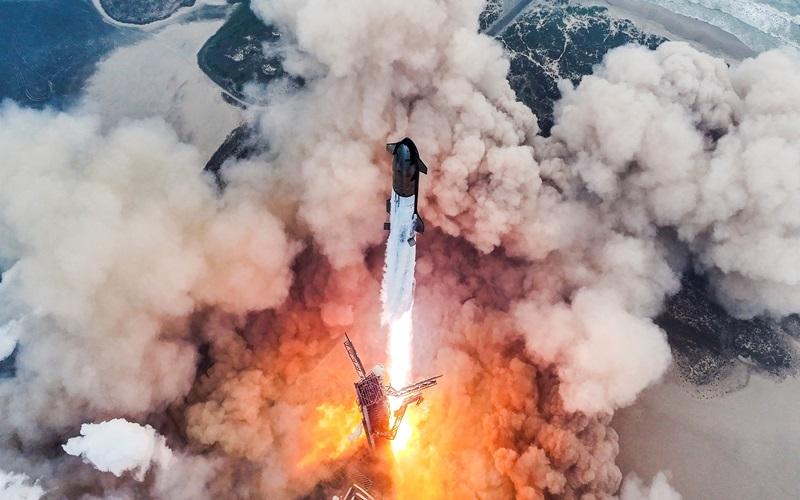SpaceX's Starship survives return to Earth, aces landing test on fourth try

SpaceX's Starship rocket survived a fiery, hypersonic return from space and achieved a breakthrough landing demonstration in the Indian Ocean on Thursday, completing a full test mission around the globe on the rocket's fourth try.
Starship's controlled fall into the Indian Ocean just 65 minutes after launching from Texas capped the latest advance in the company's test-to-failure rocket development campaign, a multibillion-dollar effort by Elon Musk's space company to build a reusable satellite launcher and moon lander.
The three previous test missions ended with Starship blowing up or disintegrating. Testing has a ways to go. Musk has said SpaceX is planning at least six Starship test flights this year, with more expected in the years ahead as it faces pressure from NASA to demonstrate it can safely put astronaut crews on the lunar surface.
The two-stage, rocket system, which stands nearly 400 feet (120-meter) tall, consists of the Starship vessel mounted atop its towering Super Heavy rocket booster. At 7:50 a.m. CDT (1250 GMT), it blasted off from SpaceX's Starbase launch site near Boca Chica Village in South Texas, sending powerful shockwaves rippling through the Gulf Coast's morning fog.
Super Heavy detached from the Starship upper stage at an altitude of 74 km (46 miles), as Starship ignited its own engines to ascend further toward space. Meanwhile, Super Heavy returned to the Gulf of Mexico and executed a soft splashdown, demonstrating a touchdown that would otherwise be on land.
In space, a SpaceX livestream showed Starship, outfitted with onboard cameras, coasting around 16,000 miles (25,750 km)per hour at an altitude of roughly 200 km (125 miles) as it made its way toward the Indian Ocean for a return to Earth, setting up for a key demonstration of its reusable design.
The rocket's first launch in April 2023 exploded minutes after liftoff some 25 miles (40 km) above ground, while its second attempt in November blew up after reaching space. The rocket's third test flight in March made it much farther but broke apart during atmospheric reentry some 64 km (40 miles) over the Indian Ocean.
On Thursday, Starship appeared to have overcome those past technical challenges. Beginning at about 45 minutes into flight, onboard cameras showed a field of superhot plasma forming around Starship's exterior - marking with hues of orange, red, bluish purple, and green the start of the spaceship's blazing hot plunge through Earth's atmosphere.
As Starship's descent was slowed by violent atmospheric friction, bits of metal and its hexagonal heat-shield tiles began flying off and parts of the rocket's steering flaps were stripped to a skeleton, though they remained functional.
Starship reignited an engine to flip itself upright in mid-descent, as it would for a landing on ground or on the moon, then splashed into the Indian Ocean, as confirmed by waves of water seen through an onboard camera's broken, debris-covered lens.
'Starship made it all the way'
"Despite loss of many tiles and a damaged flap, Starship made it all the way to a soft landing in the ocean!" SpaceX CEO Elon Musk, who had said Starship's reentry was the mission's biggest goal, posted on social media after the splashdown.
The rocket was partly covered with hundreds of small black tiles designed to protect against the extreme heat encountered while diving through Earth's atmosphere at hypersonic speeds.
Meant to be cheaper and more powerful than SpaceX's workhorse Falcon 9 rocket, Starship's totally reusable design represents the future of the company's dominant satellite launch and astronaut business. It is due to be used by NASA in the next few years to land the first astronauts on the moon since 1972.
Much is riding on SpaceX's development of Starship, relied upon by NASA as it aims to return astronauts to the moon in 2026 in a rivalry with China, which plans to send its astronauts there by 2030. China has made several recent advances in its lunar program, including a second landing on the moon's far side in a sample retrieval mission.
Despite Starship's development appearing quicker than other rocket programs, it has been slower than Musk originally envisioned. A Japanese billionaire who in 2018 paid to fly Starship around the moon, at the time expected to occur last year, canceled his flight last week, citing schedule uncertainties.
Musk's drive to rapidly build Starship has endangered SpaceX workers in Texas and California, a Reuters investigation found.
Musk, who founded SpaceX in 2002, has said Starship must launch hundreds of times before it carries humans, suggesting it could be years before the rocket flies crews or lands astronauts on the lunar surface.
SpaceX routinely flies astronauts to and from the International Space Station in low-Earth orbit for NASA using its Crew Dragon capsule, which launches atop the company's Falcon 9 rocket. No private company has ever sent humans to the moon. — Reuters




